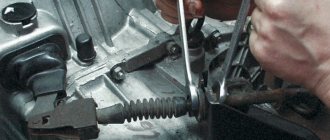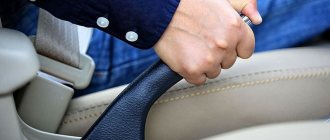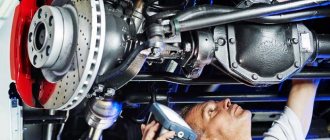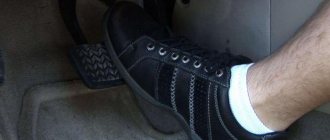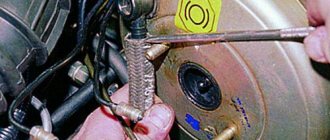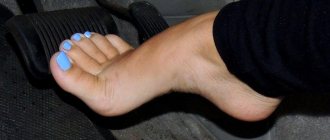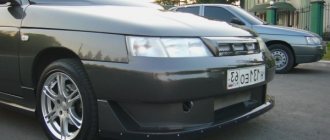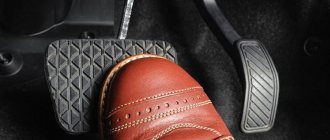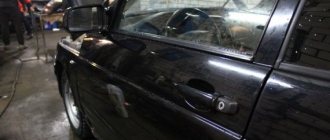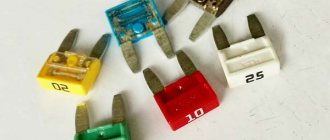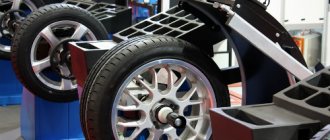There are six main reasons why brake pads squeak . The simplest and most commonplace thing is their wear. However, in addition to this, the cause of squeaking can be brake discs, wheel bearings, incorrectly selected brake pads, dust, dirt, moisture or any small objects getting into the braking system.
As a rule, to eliminate the listed reasons, it is necessary to carry out an audit of the specified components and mechanisms. This can be done yourself, provided that you have experience in performing such repairs and have the appropriate tools. Naturally, eliminating the causes of squeaking brake pads yourself will save you money. However, remember that you must be confident in the final serviceability of the car’s braking system, because it is a critically important component and directly affects the safety of all road users.
Causes of squeaks
First of all, it is worth pointing out that in 90% of cases (and maybe more often) the front pads squeak. Therefore, the check must begin with them. This is explained very simply. During braking, the weight of the car is transferred forward, the bottom of the body lowers slightly, and the rear rises. Accordingly, the front pads experience greater load compared to the rear ones. And the sharper the braking process, the more intense the work of the front pads.
Caliper and guides
In this case we are talking about the boot of the main piston, as well as the guides. A situation often arises when it breaks due to mechanical damage or simply from old age, after which dirt, sand, moisture and any small debris gets inside it. Naturally, during driving and braking, this entire mixture rubs against metal surfaces, wearing them out.
The consequence of this may be a situation where the guides and the piston itself may simply jam . In turn, this will cause the pads to not return to their original position after braking. That is, they remain in a compressed position, heating up the brake disc and preventing the car from moving. Often this moment is accompanied by a creaking noise, which is caused by overheating of the disc, pads, and their wear. By the way, in this case, significant wear of the brake disc occurs; by its appearance (darkening from high temperature) one can indirectly determine the breakdown.
Brake pads
Even if the brake pads are not very worn, and perhaps even new, there are still a number of objective reasons why they may squeak/whistle after replacement. The first reason is the purchase of a low-quality non-original pad. Usually the original spare part is of high quality and such a block will not creak (with very rare exceptions). But manufacturers of non-original consumables usually save on their products.
In particular, cheap pads usually have a low-quality friction layer applied, which gradually wears out during braking. It can be of two types - soft and hard. The soft one wears out faster (after approximately 15 thousand kilometers), but is gentle on the disc and usually does not cause squeaks. But if the pad has a hard friction layer, then it wears out the brake disc much more and is often the cause of squeaking. But the advantage of such pads is their durability - up to 30 thousand kilometers or more.
Another reason for the presence of squeaks may be the absence of cuts and/or bevels on the surface of the block. The fact is that during the braking process, the surface of the pad is not completely (not ideal, depending on the type of pad and the installation process) adjacent to the disc, even if the system works correctly and the installation was done professionally. Therefore, during the braking process, when the surfaces of the pad and disc interact, a sound resonance occurs, which the human ear perceives as a squeak.
Some types of brake pads are equipped with so-called anti-squeak plates from the factory. As their name suggests, they serve to prevent pad squeaking and vibration during braking and also help dissipate heat. Accordingly, if they are absent, the block may produce sounds that are unpleasant to the ear.
Brake discs
During the braking process, due to friction, heat is generated on the surface of the brake disc, and the disc itself heats up. When the critical temperature reaches (this depends on the specific disc and the metal from which it is made), the disc may make unpleasant sounds, similar to squeaking and/or squeaking. Old, unventilated disks are especially susceptible to this phenomenon. They don't have holes to allow heat to escape, so they heat up faster and stay warm longer.
However, there are times when ventilated discs also squeak. But this happens if they are significantly worn out or after intense (for example, emergency) braking, when they similarly overheat.
Squeakers
Another name for them is creaks. These are special brackets that are installed on some brands of brake pads. Their purpose is to touch the disc when the pads are critically worn during braking and make squeaking sounds, thereby notifying the car owner that the brake pads need to be replaced.
Wheel bearing
We are talking about significant wear of the wheel bearing when it begins to play and heat up the wheel hub. Because of this, heat from the hub is transferred to the brake caliper, disc and pads. And due to their heating, a squeak will be heard. Please note that if the wheel bearing is very worn, it can whistle at speeds , and the higher the speed, the greater the whistle.
External factors
In this case we are talking about dirt, sand, small debris, moisture, and so on. The listed elements, when driving in wet or frosty weather, when driving on mud or sand, getting into the gap between the pad and the disc, can produce squeaks. In some cases, a frozen friction layer can also make unpleasant sounds.
1. The first most common reason is worn components (brake disc, pads)
Brake pad wear
Indeed, not all car enthusiasts change components on their cars on time. They don’t take care of their “iron horse”, and then they wonder: “Why does the car make strange sounds?”
In particularly advanced cases, car enthusiasts wear the pads down to zero, down to the metal backing. The phenomenon is rare, but it does happen. Metal begins to rub against metal, producing a grinding noise unbearable for all living things. Terribly irresponsible attitude towards safety!
It's just the finish line!
With such “pads” the car stops braking completely. It begins to be pulled to the side, and the caliper pistons come out of their seats so far that they can jam the wheel at any moment!
Worn to zero - on the left and a new block - on the right
To prevent this kind of excesses, engineers came up with a “pad wear indicator” - a metal bracket protruding two to three millimeters above the surface of the supporting metal plate. When it's time to change the pads, you will hear a slight scratching sound. Don't ignore it, because it's time to replace your old pads. If possible, purchase pads with this indicator; it is not supplied by all brake pad manufacturers.
A finger in a blue glove points to the wear indicator – the “squeaker”
Methods for eliminating squeaks
Methods for eliminating squeaking noise from brake pads depend on the reasons listed above.
Caliper and guides
First of all, it is necessary to check the condition of the boot and its integrity. If dirt has accumulated in it, then it is necessary to inspect it and replace it. At the same time, do not forget to check the free movement of the caliper and its piston. They should move freely and not interfere with the return of the brake pads to their original position.
To check, you can simply simulate braking with your hand by pressing on the piston, which will press the pads to the disc. After this, they should freely fall into place. If this does not happen, then it is necessary to inspect the caliper and its constituent elements. In this case, do not forget to use special lubricants for the calipers and guides. Very often, the problem with squeaking when braking is solved by simply rebuilding the caliper and lubricating the guides and outer sides of the pads.
Brake caliper repair kit. Set composition, application, manufacturers
Caliper repair kits are individual for each car. Often the kit includes sealing rings, guides, adjusting screws, adjustment devices, and lubricants. More details
Brake pads
Anti-squeak grooves on new pads
As for eliminating the first indicated reason, here it is only worth recommending for purchase more or less high-quality (not necessarily original) brake pads. That is, those that have a friction layer of average softness.
Sound resonance can be eliminated in different ways. The first of them also consists in recommending the purchase of those pads on the surface of which there are special cuts and bevels designed specifically for these purposes. Most of these products have them by default. You can also make such cuts yourself. However, please note that sawing off a large piece of the plate is dangerous, as this will reduce its efficiency! In addition, you need to know the place where to do this. Usually, to do this, a chamfer is removed along the perimeter of the block, and a narrow groove is made in the middle. For work you can use a grinder.
How to chamfer a block
Also, sound resonance can be eliminated using so-called anti-creaking plates. They are sold separately in stores and are subsequently installed on the brake pads. How to do this is indicated in their operating instructions. If you decide to buy anti-squeak plates, when installing them, do not forget to use the special lubricant that comes with them, which must be applied to the back side of the lining. Most manufacturers complete their pads with such metal plates, but you can also come across them without them.
Another function of anti-squeak pads is to remove heat from the brake disc . This will help extend its service life. It is worth noting that reviews of the use of anti-squeak plates from various car owners who have used them are very mixed. They can be summarized as follows: if the friction material of the pads is good, then the plates can help, but if the pad is initially of poor quality, then no anti-squeak plates will help.
Brake discs
Depending on the condition of the disks, you can take different routes to eliminate their squeaks. The simplest and most effective is to replace the old non-ventilated disk with a ventilated one. To do this, you need to know the brand and size of the product and select a spare part from the catalog or directly in the store. However, some older vehicles do not have non-ventilated discs.
Another option is to analyze the condition of the brake disc. If it is very worn, it can be sharpened or replaced with a new one. An indirect sign that the disc has “lost” is when the car brakes jerkily. Grooving the disc is possible only when it is slightly worn and its thickness is sufficient to remove a certain layer of metal using a machine. However, the best solution in this case would be to replace the disk with a new one. This will protect you from breakdowns and accidents on the roads in the future.
Wheel bearing
There is no point in repairing the wheel bearing, and even this is impossible, and driving with it is very dangerous, since there is a risk that the wheel will completely jam at speed, which can create a fatal emergency situation. Therefore, in this case there is only one way out - complete replacement of the bearing.
External factors
In most cases, this phenomenon is temporary. Typically, creaking in such cases appears when driving through mud, sand, or in frosty weather shortly after driving the car after a long stay. As a rule, after 5...10 minutes of driving under normal conditions, the squeaking stops.
Squeakers
Squeaker device
In this case, there is only one way out, and it consists in replacing the pads with new ones. Remember that they need to be changed in pairs , on each axle (on the front or rear axle, or on both at once). Moreover, no matter what condition the other pad is in, otherwise it will wear out much faster, and its operating efficiency will be lower than that of the newly installed one.
Principle of operation
All hydraulic brake systems operate on the same principle:
When you press the brake, the pressure in the brake hydraulic system increases, the brake calipers, through the pistons, press on the brake pads, which are pressed against the disc or drum and, due to the frictional force, slow down or stop it. The pressure (of the calipers) in the brake system directly depends on the force of pressing, that is, on the distance that the brake pedal has traveled. In other words, by pressing the force, you can regulate the pressure and change the braking torque, that is, slow down, or vice versa, with full pressure, you can brake urgently.
The source of unpleasant, extraneous sounds in the brakes can only be moving parts:
- pads (front and rear);
- caliper (piston);
- brake discs or drums (deformation);
- brake pedal (lubrication);
- wheel hub (play);
Interesting Facts
Some new brake pads have what is called a primer . It is located above the main friction material. After installing such a new pad, when driving in the first 50...100 kilometers, a squeak may occur due to the rubbing of the pads and wear of the initial layer. That's why new pads squeak after replacement. This should be taken calmly and taken for granted. However, in order to save nerves, before purchasing certain brake pads, it is necessary to clarify information about whether they have the mentioned initial layer.
Sometimes pad squeaking also occurs on drum brakes. A striking example of this is the popular Renault Logan car. He has a so-called childhood disease, which is expressed in the fact that during heavy braking, the pads (especially new ones) can cling to the support shield. The elimination of this drawback, which means that the pads do not cling and creak, consists of rubbing the friction point with sandpaper.
Also, occasionally, metal chips stick to the disc and drum brake pads. It causes a quiet squeak and a decrease in braking efficiency. To get rid of this phenomenon, you need to dismantle the pads and remove such deposits using fine sandpaper. Please note that you need to work carefully so as not to damage the pad and its working surface.
Conclusion
The search for the reasons why brake pads squeak should always begin with checking their condition. Most often, especially on cars with high mileage, their owners simply forget to replace them, and the pads create a squeak during braking due to wear. Remember that the pads must be changed in accordance with the requirements of the manufacturer of your car. They are often allowed to be used until they reach critical wear. On other cars, the pads need to be changed after a certain mileage (for example, 30 thousand kilometers).
If everything is in order with the pads, then you need to carefully check the above-mentioned components and elements of the car’s brake and chassis systems. Remember that repair work must be carried out responsibly so that the car’s brakes work flawlessly in the future!
